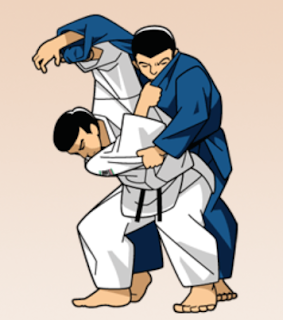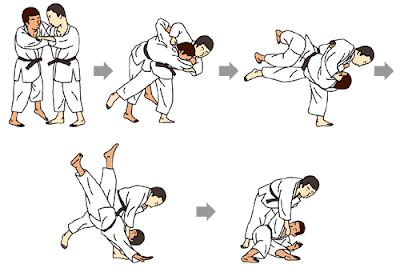Tai-otoshi has been described as a safe but difficult technique to do.
It's safe because it's not such an easy technique to counter. If it fails, you can abort and get out rather safely.
But it's quite a difficult technique to do. This principally has to do with the hand movement, which is quite complex and tends to be overlooked.
Because tai-otoshi involves tripping uke over tori's extended leg, many people think of it as a leg technique and focus mainly on the legs movements.
Actually the key to a successful tai-otoshi is the hand movements, especially the tsurite (lapel) hand. There's a lot of confusion about what it's supposed to do. The body positioning is also important. These are things we will look at in detail tonight.
The traditional tai-otoshi is done with a sleeve-lapel grip and it's done from a kenka-yotsu (opposite stance) situation. In its traditional form, tai-otoshi cannot be done from an ai-yotsu (same stance) situation because the angle is all wrong. To deal with that, we have to look at some competition variations, in particular the sleeve version.
There are many other variations of tai-otoshi that we could look into such as the cross-grip version and the drop version but for tonight, we'll stick to the classical version and the sleeve version as we want the players to have time to work on their tokui-waza,
It's safe because it's not such an easy technique to counter. If it fails, you can abort and get out rather safely.
But it's quite a difficult technique to do. This principally has to do with the hand movement, which is quite complex and tends to be overlooked.
Because tai-otoshi involves tripping uke over tori's extended leg, many people think of it as a leg technique and focus mainly on the legs movements.
Actually the key to a successful tai-otoshi is the hand movements, especially the tsurite (lapel) hand. There's a lot of confusion about what it's supposed to do. The body positioning is also important. These are things we will look at in detail tonight.
The traditional tai-otoshi is done with a sleeve-lapel grip and it's done from a kenka-yotsu (opposite stance) situation. In its traditional form, tai-otoshi cannot be done from an ai-yotsu (same stance) situation because the angle is all wrong. To deal with that, we have to look at some competition variations, in particular the sleeve version.
There are many other variations of tai-otoshi that we could look into such as the cross-grip version and the drop version but for tonight, we'll stick to the classical version and the sleeve version as we want the players to have time to work on their tokui-waza,


















